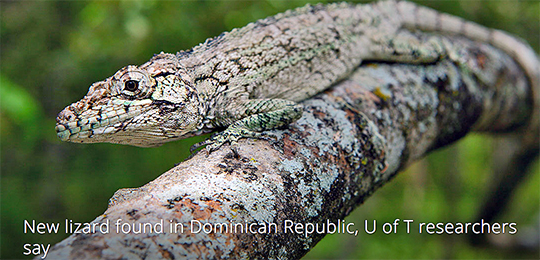Discovery of a Giant Chameleon-Like Lizard
New AmNat paper out now!

Check out latest from the Mahler lab in an American Naturalist paper describing Anolis landestoyi, a new Dominican anole that looks like it should be from Cuba. This lizard was first spotted by naturalist extraordinaire Miguel Landestoy, and it provides fresh evidence for among-island ecomorphological matching in anoles. The article is here. Check it out!
Discovery of a Giant Chameleon-Like Lizard (Anolis) on Hispaniola and Its Significance to Understanding Replicated Adaptive Radiations
D. Luke Mahler,1,* Shea M. Lambert,2 Anthony J. Geneva,3 Julienne Ng,4 S. Blair Hedges,5
Jonathan B. Losos,3 and Richard E. Glor6
- Department of Ecology and Evolutionary Biology, University of Toronto, Toronto, Ontario M5S 3B2, Canada;
- Department of Ecology
and Evolutionary Biology, University of Arizona, Tucson, Arizona 85721; - Department of Organismic and Evolutionary Biology and
Museum of Comparative Zoology, Harvard University, Cambridge, Massachusetts 02138; - Department of Ecology and Evolutionary
Biology, University of Colorado–Boulder, Boulder, Colorado 80309; - Center for Biodiversity, Temple University, Philadelphia,
Pennsylvania 19122; - Herpetology Division, Biodiversity Institute and Department of Ecology and Evolutionary Biology,
University of Kansas, Lawrence, Kansas 66045
* Corresponding author e-mail: luke.mahler@utoronto.ca
Abstract:
We report a new chameleon-like Anolis species from
Hispaniola that is ecomorphologically similar to congeners found
only on Cuba. Lizards from both clades possess short limbs and a
short tail and utilize relatively narrow perches, leading us to recognize a novel example of ecomorphological matching among islands in the well-known Greater Antillean anole radiation. This discovery supports the hypothesis that the assembly of island faunas can be substantially deterministic and highlights the continued potential for basic discovery to reveal new insights in well-studied groups. Restricted to a threatened band of midelevation transitional forest near the border of the Dominican Republic and Haiti, this new species appears to be highly
endangered.
Keywords: community assembly, determinism, conservation, island
biogeography, Dominican Republic.
The American Naturalist, 2016; 000 DOI: 10.1086/687566
In the News
- U of T News
- Science Daily
- Scienmag Science Magazine
